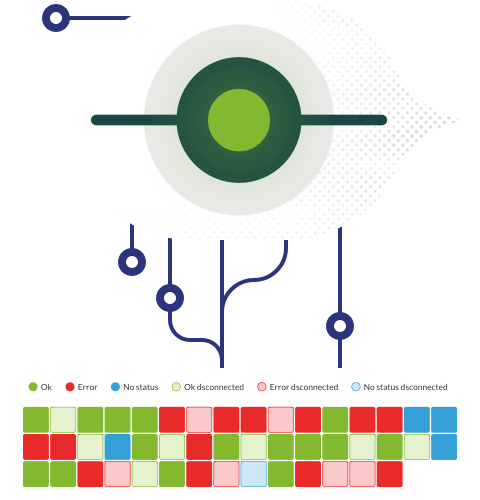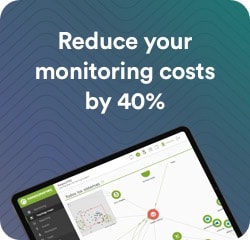All these initiatives are based on connectivity together with efficient and steady network monitoring, since the impact of an interruption or inactivity of a company may translate into financial losses (unsettled transactions, loss of revenue); reduced efficiency (interruption in production flows or supply chain); additional costs (for unexpected repairs, fines for breach of contract); customer dissatisfaction (delays in order shipping) and employees (operation disruptions).
In this context, a network operations center or NOC (Network Operations Center), with the appropriate network monitoring and control tools, contributes to ensuring business continuity and the best user and customer experience.
What is a NOC?
A NOC, also known as a “Network Operations Center,” is one or more locations from which network monitoring and control is carried out through a computer, telecommunications, or satellite network.
Difference between NOCs and SOCs
Both NOC and SOC focus on the management and protection of an organization’s infrastructure (systems and networks), although their roles differ by their objectives. Recently, in IT Topic: What is Security Information and Event Management (SIEM), we had commented that the SOC (Security Operations Center) continuously monitors and improves the security structure of an organization; while NOC is dedicated to the management and monitoring of corporate networks.
Main Functions of a NOC
A NOC must work continuously to ensure business continuity, where IT employees monitor network status 24 hours a day (https://pandorafms.com/en/it-topics/measuring-bandwidth-and-network-consumption-a-full-guide/, latency, packet loss), seeking to detect whether something impacts its operation and performance to solve it, and even take preventive actions, having as main functions the following:
- Continuous IT and network monitoring: Monitor network infrastructure to ensure optimal system availability and performance.
- Incident Management: Manage incidents based on clearly defined processes and procedures to detect, report and solve network incidents in order to prevent service inactivity or disruptions.
- Security and regulatory compliance: Monitor threats and vulnerabilities, in addition to undertaking measures to protect against cyberattacks on the network. Also, a NOC analyzes network performance metrics and ensures service levels (compliance with SLA) and regulatory compliance.
Also in a NOC, network configuration management and documentation (including changes, updates and patches) is carried out in order to have the information that allows network troubleshooting. Additionally, the root cause of recurring problems is analyzed to prevent future incidents.
NOC Components
A NOC is made up of people, processes, and platforms like this:
- People with key roles such as technicians, analysts and engineers.
- NOC technicians or operators: They are the ones who monitor and manage the network in real time, identifying and solving incidents.
- Network analysts: In charge of analyzing network traffic in order to identify possible network problems and from there, optimize its performance.
- NOC Engineers: They are specialists in network design, implementation and maintenance. Their level of knowledge allows them to solve complex technical problems and undertake improvements aimed at optimizing network performance.
- Incident managers: Those who coordinate the response to critical incidents, based on defined procedures to ensure efficient resolution.
- Security specialists: Those who have the knowledge to detect and prevent cyberattacks.
There are also change coordinators, in charge of network updates in a coordinated manner to minimize the impact on the service level; and system administrators, in charge of maintaining and managing the systems and servers that support the network infrastructure. Leading this team is the NOC Manager, overseeing daily operations to meet service standards.
- Processes, with standard procedures (such as ITIL, ISO).
In a NOC, reference frameworks must be taken into consideration to manage and improve IT services such as ITIL (Information Technology Infrastructure Library) and ISO (International Organization for Standardization, such as ISO 27001), with standards that work as a guide for the efficiency and quality of business network services, in addition to complying with security requirements. - Plataforms: Essential tools such as IT monitoring software and ticketing systems. The equipment operating in a NOC requires monitoring systems with the ability to see in real time the status of the network to detect any threat that impacts its performance. Software is also required to manage and monitor devices connected to the network. Another component is security tools to detect and mitigate attacks or vulnerabilities. Another very useful tool is ticketing systems to track and manage incidents (who generated the ticket and how it was solved), based on support or customer/user service “tickets”. With these tools, the NOC may carry out its core functions of monitoring and managing networks and regulatory compliance.
NOC Components: People, Processes and Platforms

Understanding what a NOC is involves recognizing the importance of these tools in maintaining smooth operations.
Benefits of implementing a NOC
Implementing a NOC with the right tools allows the operational and expert team to reap its benefits:
- Downtime reduction: Through ongoing network monitoring, updating and patch application, it is possible to prevent downtime. With monitoring tools (preferably from the same platform) it is possible to solve incidents early and even proactively. Maintenance can also be scheduled without interrupting the daily operation of the company.
- Improved network performance: Through centralized monitoring systems, it is possible to monitor data flows, bandwidth and device performance to anticipate possible problems that may arise in the future or at “peak” demand times.
- Predictable costs and operational efficiency: Proper network management with security measures avoids the impact of the inactivity we mentioned at the beginning (financial, operational and reputational impact), in addition to preventing situations in which the company must incur costs associated with repairs (a remedy is always more expensive) or expensive penalties. Also, the NOC can analyze the information obtained from ticketing or monitoring to develop infrastructure optimization proposals or make decisions to avoid unnecessary investments.
- Reporting and compliance: Through strong monitoring tools, it is possible to have incident records, their monitoring and resolution. There are also the necessary elements to generate reports and security and vulnerability audits on a regular basis to identify improvements.
How Pandora FMS optimises NOCs
Pandora FMS offers comprehensive monitoring solutions with real-time information, with full observability, as it has the capabilities to:
- Centralize monitoring: It offers network monitoring and security from the same platform, with custom metrics and centralized alerts, which streamlines the operation of the NOC team. Your whole team stays informed (on one screen or shared) about system performance levels through remote and coordinated monitoring. For Managed Service Providers (MSP), it is the ideal solution for you to provide your customers with 24/7 hybrid infrastructure monitoring, administration and management services, monitoring physical and cloud environments, as well as managing them remotely.
- Alert and incident automation: It enables alert automation based on commands (which specify what will be done), actions (how it will be done) and templates (when it will be done, based on certain conditions). Implementing automated alerts prevents Alert Fatigue, which only adds stress to your team and distracts you from what is most critical.
- Customizable reports and key metrics: Pandora FMS offers a report builder that allows you to design your reports, customized with covers, headers and different contents. You may have your dashboard with real-time display of network and system data, as well as having a multi-year history available. You may also get reports on compliance with service levels (Management of SLA on a monthly, weekly or daily basis), histograms, graphs, inventories and device configuration, among others. Its ability to manage IT services (ITSM) is a powerful and flexible Helpdesk for support and customer service teams (in accordance with ITIL processes) as well as being able to report to your customers, based on predefined templates.
- Scalability to manage multiple infrastructures: At Pandora FMS you may manage the configuration of hundreds of agents in a simple way, with a couple of clicks. Through policies, thousands of computers can be managed consistently. Policies allow for reuse and distribution of changes across large system groups.
It is also worth highlighting that the federated structure of Pandora FMS allows to distribute the whole load between different nodes, so that the processing load is shared and processed simultaneously. The platform Command Center allows you to visualize and manage all the information together, in addition to the fact that we have licenses for several hundred thousand agents in operation.
Conclusion
To ensure business continuity and operational resilience, a NOC makes business network monitoring and control easier, seeking to undertake corrective and preventive actions, in addition to optimizing their performance. Keep in mind that a NOC requires PEOPLE, PROCESS, and PLATFORMS. People (technicians, analysts, engineers, specialists) must follow processes with frameworks (ITIL, ISO) to manage and improve IT services, relying on robust platforms such as Pandora FMS for real-time monitoring of network status, in order to obtain the benefits of NOC: reduce downtime, improve performance, optimize costs and have the audit and compliance bases.
For that purpose, the differential value of Pandora FMS solution is that it has been designed to centralize network monitoring, promoting collaboration, analysis and coordinated actions; the automation of customizable alerts, reports and metrics; the scalability to manage multiple infrastructures; and the federated design to distribute the load between different network nodes. We invite you to contact one of our consultants to support you in the implementation of your NOC, the development of custom integrations and features, and even in training full operation teams.
[1] Sources: IDC Black Book, October 2024; FMI World Economic Outlook, November2024.
Can one tool have global visibility?









